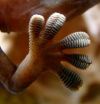(Press-News.org) The Pacific Northwest has been inundated with wildfires most stemming from lightning strikes during summer storms. Four of these wildfires can be seen in this natural-color Aqua satellite image collected by the Moderate Resolution Imaging Spectroradiometer, MODIS, instrument aboard. This image was taken on August 11, 2014. Actively burning areas, detected by MODIS's thermal bands, are outlined in red.
The Upper Falls wildfire was started by a lightning strike on August 03. It is located 17 Miles North of Winthrop WA, 37 miles Northwest of Omak, WA and has grown to 7,100 acres with 449 personnel fighting the blaze. A red flag warning has been issued for this fire from 12pm today through 5 PM Wednesday. Dry and unstable conditions followed by thunderstorms with abundant lightning are forecast.
The Little Bridge Creek Fire started at approximately 6:30pm on Saturday, August 2, on the Okanogan-Wenatchee National Forest, 10 miles west of Winthrop Washington. The fire was naturally caused, likely by lightning and has grown to 4,000 acres. Approximately 703 persons are in camp this morning. The fire is located in a very steep, roadless area in heavy timber with a large component of bug killed trees. No structures or infrastructure are immediately threatened. As with the Upper Falls wildfire, there is a red flag warning in place.
From the air, the Lone Mountain Fire is now a 2700-acre mosaic of rock, steep slopes, alpine meadows and burned and unburned forest. The fire began on July 14 most likely with a lightning strike. To date, firefighters continue to monitor the fire from helicopters and from the ground, calling in 300-gallon bucket-loads of water if flare-ups appear to have any chance of threatening the control points. The Lone Mountain Fire sits in a bowl ringed by mountains on three sides. It has gradually burned northward up Rennie Creek and westward down Boulder Creek. Fire fighters are on alert for hot and possibly windy weather plus lightning tonight and Tuesday. A fire weather watch has been declared.
The Duncan fire began on July 16 with a lightning strike. Over 10,400 acres have been burned to date. Two hundred sixty one personnel are currently fighting this blaze. The Duncan, Shoofly, Hansel Creek, and Chiwaukum fires may all see growth today and smoke columns may form in the afternoon. Duncan Fire crews continue to strengthen control lines along Shady Pass Road. The fire will likely see increased activity today, assisted by the anticipated Red Flag Warning conditions.
Brief but intense showers are possible but will do little to moderate longer term fire conditions. Historically, autumn rains have arrived about October 15, extinguishing any lingering smokes in the North Cascades.
INFORMATION:
NASA image courtesy Jeff Schmaltz LANCE/EOSDIS MODIS Rapid Response Team, GSFC.
Fires in Northern Washington State
2014-08-12
ELSE PRESS RELEASES FROM THIS DATE:
NASA sees a weaker Tropical Storm Julio far north of Hawaii
2014-08-12
Tropical Storm Julio continues to weaken as it moves through cooler waters of the Central Pacific Ocean. NASA's Terra satellite passed over Julio and saw that the bulk of the clouds and precipitation were being pushed to the34 north of the center as the storm tracked far north of the Hawaiian Islands.
NASA's Terra satellite passed over Julio on August 11 at 21:25 UTC (5:25 p.m. EDT) and the Moderate Resolution Imaging Spectroradiometer or MODIS instrument aboard took a visible picture of the storm. The MODIS image revealed a circular center, but most of the clouds and ...
Copper foam turns carbon dioxide into useful chemicals
2014-08-12
PROVIDENCE, R.I. -- A catalyst made from a foamy form of copper has vastly different electrochemical properties from catalysts made with smooth copper in reactions involving carbon dioxide, a new study shows. The research, by scientists in Brown University's Center for the Capture and Conversion of CO2, suggests that copper foams could provide a new way of converting excess CO2 into useful industrial chemicals.
The research is published in the journal ACS Catalysis.
As levels of carbon dioxide in the atmosphere continue to rise, researchers are looking for ways to make ...
Geckos use toe hairs to turn stickiness on/off
2014-08-12
WASHINGTON D.C. Aug. 12, 2014 -- If you've ever spent any time watching a gecko, you may have wondered about their uncanny ability to adhere to any surface -- including upside down on ceilings. It turns out the little lizards can turn the "stickiness" of toe hairs on the bottom of their feet on and off, which enables them to run at great speeds or even cling to ceilings without expending much energy.
In the Journal of Applied Physics, from AIP Publishing, Oregon State University (OSU) researchers describe their work exploring the subtleties of geckos' adhesion system ...
No excess baggage: Antarctic insect's genome, newly sequenced, is smallest to date
2014-08-12
COLUMBUS, Ohio – Scientists who sequenced the genome of the Antarctic midge suspect the genome's small size – the smallest in insects described to date – can probably be explained by the midge's adaptation to its extreme living environment.
The midge is a small, wingless fly that spends most of its two-year larval stage frozen in the Antarctic ice. Upon adulthood, the insects spend seven to 10 days mating and laying eggs, and then they die.
Its genome contains only 99 million base pairs of nucleotides, making it smaller than other tiny reported genomes for the body ...
Scientists discover the miracle of how geckos move, cling to ceilings
2014-08-12
CORVALLIS, Ore. – Researchers at Oregon State University have developed a model that explains how geckos, as well as spiders and some insects, can run up and down walls, cling to ceilings, and seemingly defy gravity with such effortless grace.
The solution, outlined today in the Journal of Applied Physics, is a remarkable mechanism in the toes of geckos that use tiny, branched hairs called "seta" that can instantly turn their stickiness on and off, and even "unstick" their feet without using any energy.
These extraordinary hairs contribute to the ability of geckos to ...
WSU researcher sees survival story in Antarctic fly's small genome
2014-08-12
PULLMAN, Wash.—Few animals can boast of being as tough as the Antarctic midge. Its larvae develop over not one but two Antarctic winters, losing nearly half their body mass each time. It endures high winds, salt, and intense ultraviolet radiation. As an adult, the midge gets by without wings and lives for only a week or so before starting its life cycle all over again.
And as Joanna Kelley has learned, it does this with the smallest insect genome sequenced so far.
"It's tiny," said Kelley, a Washington State University assistant professor, who recently sequenced and analyzed ...
Transgender relationships undermined by stigma
2014-08-12
PROVIDENCE, R.I. — Researchers who looked at the impact of discrimination, poverty and stigma on the mental health and relationship quality of transgender women and their male romantic partners found that social and economic marginalization not only takes a psychological toll on each person individually but also appears to undermine them as a couple.
It is difficult to be a transgender woman in the United States. Prior research has shown that they generally face high risks of depression, financial hardship, and discrimination, said study lead author Kristi Gamarel, a ...
Majority of Quebec children placed in out-of-home care are reunited with their family
2014-08-12
The majority of children in Quebec's youth protection system who are placed in out-of-home care (family foster care, or in a group or rehabilitation centre) are reunited with their "natural" families within 6 months, according to a study led by Professor Tonino Esposito of University of Montreal's School of Social Work. However, younger children, specifically those aged 2 to 5 years old at initial placement, have the lowest likelihood of returning to live with their natural families over time. "All placed children, irrespective of age, are less likely to return to live ...
Scared of crime? Good.
2014-08-12
EAST LANSING, Mich. -- In the past half-century, fear of crime in the United States has fueled "white flight" from big cities, become known as a quality of life issue and prompted scholars and law enforcement experts to address ways of reducing this fear.
But a study by a Michigan State University criminologist challenges this longstanding theory by arguing that a healthy fear of crime is, in fact, a good thing.
The study, published online in the journal Justice Quarterly, suggests adolescents who are more fearful of crime are less apt to become victims and offenders ...
ADHD, substance abuse and conduct disorder develop from the same neurocognitive deficits
2014-08-12
This news release is available in French. Researchers at the University of Montreal and CHU Sainte-Justine Research Centre have traced the origins of ADHD, substance abuse and conduct disorder, and found that they develop from the same neurocognitive deficits, which in turn explains why they often occur together. "Psychopathology exists on multiple continua of brain function. Some of these dimensions contribute to a multitude of problems, others contribute to specific problems. Together, they explain patterns of comorbidity such as why ADHD and conduct problems co-occur ...







